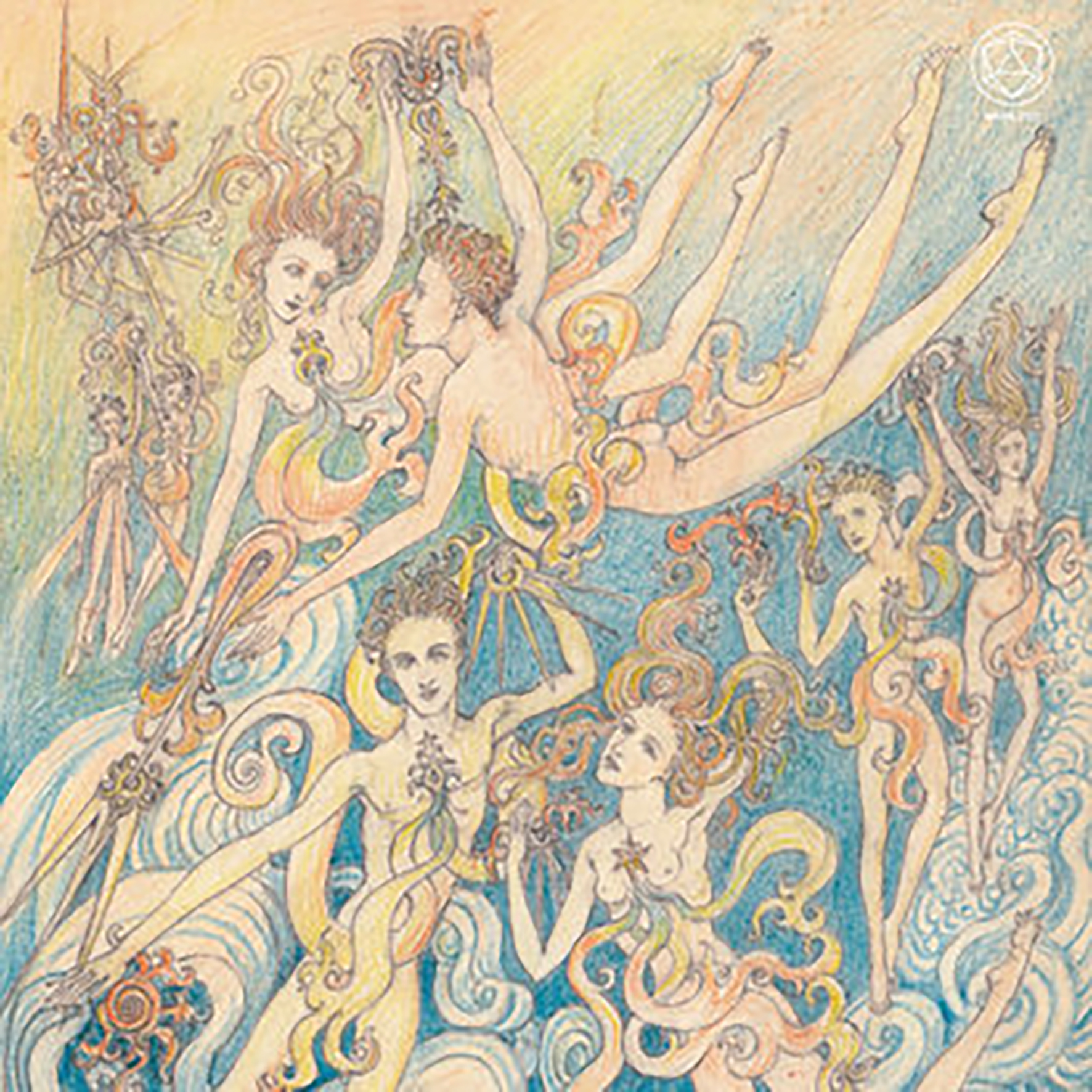Téléplasmiste, "To Kiss Earth Goodbye"
 It has been three years since this eclectic duo last released a proper full-length, though they have released a few fitfully intriguing cassettes in the interim. While I enjoyed the looser, more abstract side of the project showcased on last year's Science Religion, it did not quite build upon the incredible promise of Frequency is the New Ecstasy's incredible "Astodaan." That particular piece suggested that Téléplasmiste might someday deserve their own place in the illustrious Coil/Cyclobe continuum of heavy, occult-tinged, post-industrial psychedelia, though neither Mark Pilkington or Michael J. York are exactly starving for underground cred (Pilkington runs Strange Attractor Press and York was briefly a touring member of Coil). The twist is that the two artists make for a pair every bit as curious and improbable as Golden Retriever, as York's expertise in bagpipes and other wind instruments is hardly common as a guiding force in the post-industrial milieu and Pilkington is not exactly a conventional musician himself. In the context of Téléplasmiste, however, the pair tend to focus on combining heady synth drones and eerie, ritualistic pipes to evoke something akin to a portal to an altered state of consciousness. Occasionally their more bubbly kosmische side rubs me the wrong way, but the lion's share of this album is both wonderful and mesmerizing.
It has been three years since this eclectic duo last released a proper full-length, though they have released a few fitfully intriguing cassettes in the interim. While I enjoyed the looser, more abstract side of the project showcased on last year's Science Religion, it did not quite build upon the incredible promise of Frequency is the New Ecstasy's incredible "Astodaan." That particular piece suggested that Téléplasmiste might someday deserve their own place in the illustrious Coil/Cyclobe continuum of heavy, occult-tinged, post-industrial psychedelia, though neither Mark Pilkington or Michael J. York are exactly starving for underground cred (Pilkington runs Strange Attractor Press and York was briefly a touring member of Coil). The twist is that the two artists make for a pair every bit as curious and improbable as Golden Retriever, as York's expertise in bagpipes and other wind instruments is hardly common as a guiding force in the post-industrial milieu and Pilkington is not exactly a conventional musician himself. In the context of Téléplasmiste, however, the pair tend to focus on combining heady synth drones and eerie, ritualistic pipes to evoke something akin to a portal to an altered state of consciousness. Occasionally their more bubbly kosmische side rubs me the wrong way, but the lion's share of this album is both wonderful and mesmerizing.
In keeping with the project's founding principal of "deep awareness and respect for prior esoteric traditions and counterculture currents," To Kiss Earth Goodbye borrows its cover art from 20th century spirit painter Ethel Le Rossignol.In fact, Le Rossignol's work also provides the title for the woozy reverie of the album's second piece ("A Goodly Company").Elsewhere, Pilkington and York incorporate "a previously unheard trance recording of occultist Alex Sanders (the UK's "King of the Witches") into the album's best piece.Such arcane inspirations are obviously de rigueur for the man behind Strange Attractor Press and admirably quite far outside the current zeitgeist, yet they do not at all manifest themselves in the expected ways, which makes To Kiss Earth Goodbye a sometimes perplexing release.While the hypnotic and hallucinatory Sanders piece ("An Unexpected Visit") is absolutely sublime and sounds plucked from a great unreleased Coil album, many of the album's other pieces fall much closer to current experimental music trends than their esoteric pedigree might suggest.I suspect that is likely due to the pair's shared passion for vintage synthesizers though, as the duo have described their two Fenix II semi-modular synths as "the heart of the Téléplasmiste sound" in the past.As a result, it is not particularly surprising that this project objectively shares more aesthetic ground with classic Tangerine Dream than it does with timeless, otherworldly visions from the spirit realm (the pair are saddled with vintage earthbound tools rather than extra-dimensional ones).That is neither good nor bad, but there are some other artists more who are a bit successful at pulling back the veil to reveal an unearthly, phantasmagoric vista.There are not, however, many other artists who can rival Téléplasmiste at their best when it comes to crafting mesmerizing and psychotropic synthscapes.On To Kiss Earth Goodbye, only "An Unexpected Visit" fully captures the duo at the sustained height of their powers, but several other pieces contain some wonderfully sublime (if ephemeral) passages.
I suspect the success of "An Unexpected Visit" lies at least partially in the...ahem...unexpected visit from Sanders' voice, which adds a compelling additional layer to Pilkington and York's squirming and quivering synth melodies.Sometimes, however, the duo’s synth themes are unusual enough to stand on their own as something special and unique.I am especially fond of the burbling and lilting "A Boy Called Conjuror," which arguably resembles a woozy, time-stretched calliope intertwined with a winding pipe melody and floating, dreamlike flutes.Moreover, it strikes an evocative balance between "unsettling" and "pretty," resembling a surreal blurring together of "slow-motion folk dance" and "carnival that conceals a dark secret."Elsewhere, "Possessors of the Orb" is another highlight, as its gently fluttering ambient idyll gradually builds into an impressive crescendo of majestic-sounding bagpipes and gnarled electronics.The epic title piece is yet another second-tier highlight, slowly building from a languorous reverie of slow-moving drones into a haunting juggernaut of eerie pipes and heaving masses of dense synth tones.The album's bookends, on the other hand, feel more like an intro and an outro rather than fully formed pieces in their own right, but the opening "Come! Vehicles of Light" does contain some heavenly moments of transcendent inspiration (especially its initial theme, which calls to mind a gently swaying dreamscape of shimmering crystal chimes).
I feel quite safe in proclaiming that there will never be another Coil, as the X factor of Jhonn Balance's unique and creatively restless persona is absolutely impossible to replicate (though Alex Sanders unintentionally provides an amusingly passable Balance impression from beyond the grave in "An Unexpected Visit").As far as Coil's like-minded descendants are concerned, however, I enjoy this project almost as much as I enjoy Cyclobe.Moreover, the two projects absolutely belong together in the same sentence, as they are arguably the light and dark variations of a similarly otherworldly trip: if I want to astrally project myself into a shadow realm of dark ritual and seething menace, I could not choose a better guide than Cyclobe.If, however, I instead want to visit a sun-dappled, warm, and impressionist altered state instead, I will reach for a Téléplasmiste album.I still wind up in a haunted, mysterious, and alien place, but the ghosts at least seem like comparatively well-meaning ones.Aside from that, I genuinely appreciate Téléplasmiste's approach to synthesizers, as Pilkington and York clearly had a strong and focused vision first, then sought out the tools that would enable them to best realize it (as opposed to letting the tools themselves shape the vision).I suspect a lot of the details on To Kiss Earth Goodbye will be missed by casual listeners (or appreciated only unconsciously) as the overall spell is quite a vivid and beguiling one, but Earth is genuinely a multilayered delight: individual notes vibrantly dance, squirm, chirp, gurgle, and squeal throughout the album in an tour de force of elegant control and nuance.It is clear that an enormous amount of effort went into shaping and editing these pieces into their final form.Whether or not To Kiss Earth Goodbye surpasses Frequency is New Ecstasy, however, is hard to say.I am leaning toward "it does," but the more salient point is that Téléplasmiste are now two-for-two with their full-lengths.While neither album consistently hits the mark on every single song, the quivering and hallucinatory soundscapes that Pilkington and York conjure add up to a vividly realized and absorbing world that is uniquely their own.
Samples can be found here.



